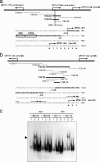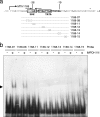Specific DNA binding of a potential transcriptional regulator, inosine 5'-monophosphate dehydrogenase-related protein VII, to the promoter region of a methyl coenzyme m reductase I-encoding operon retrieved from Methanothermobacter thermautotrophicus strain DeltaH
- PMID: 18757575
- PMCID: PMC2570296
- DOI: 10.1128/AEM.02155-07
Specific DNA binding of a potential transcriptional regulator, inosine 5'-monophosphate dehydrogenase-related protein VII, to the promoter region of a methyl coenzyme m reductase I-encoding operon retrieved from Methanothermobacter thermautotrophicus strain DeltaH
Abstract
Two methyl coenzyme M reductases (MCRs) encoded by the mcr and mrt operons of the hydrogenotrophic methanogen Methanothermobacter thermautotrophicus DeltaH are expressed in response to H(2) availability. In the present study, cis elements and trans-acting factors responsible for the gene expression of MCRs were investigated by using electrophoretic mobility shift assay (EMSA) and affinity particle purification. A survey of their operator regions by EMSA with protein extracts from mrt-expressing cultures restricted them to 46- and 41-bp-long mcr and mrt upstream regions, respectively. Affinity particle purification of DNA-binding proteins conjugated with putative operator regions resulted in the retrieval of a protein attributed to IMP dehydrogenase-related protein VII (IMPDH VII). IMPDH VII is predicted to have a winged helix-turn-helix DNA-binding motif and two cystathionine beta-synthase domains, and it has been suspected to be an energy-sensing module. EMSA with oligonucleotide probes with unusual sequences showed that the binding site of IMPDH VII mostly overlaps the factor B-responsible element-TATA box of the mcr operon. The results presented here suggest that IMPDH VII encoded by MTH126 is a plausible candidate for the transcriptional regulator of the mcr operon in this methanogen.
Figures






Similar articles
-
The methanogen-specific transcription factor MsvR regulates the fpaA-rlp-rub oxidative stress operon adjacent to msvR in Methanothermobacter thermautotrophicus.J Bacteriol. 2010 Nov;192(22):5914-22. doi: 10.1128/JB.00816-10. Epub 2010 Sep 17. J Bacteriol. 2010. PMID: 20851905 Free PMC article.
-
Transcriptional regulation of the gene encoding an alcohol dehydrogenase in the archaeon Sulfolobus solfataricus involves multiple factors and control elements.J Bacteriol. 2003 Jul;185(13):3926-34. doi: 10.1128/JB.185.13.3926-3934.2003. J Bacteriol. 2003. PMID: 12813087 Free PMC article.
-
Redox-sensitive DNA binding by homodimeric Methanosarcina acetivorans MsvR is modulated by cysteine residues.BMC Microbiol. 2013 Jul 16;13:163. doi: 10.1186/1471-2180-13-163. BMC Microbiol. 2013. PMID: 23865844 Free PMC article.
-
Archaeal chromatin and transcription.Mol Microbiol. 2003 May;48(3):587-98. doi: 10.1046/j.1365-2958.2003.03439.x. Mol Microbiol. 2003. PMID: 12694606 Review.
-
Inosine monophosphate dehydrogenase expression: transcriptional regulation of the type I and type II genes.Adv Enzyme Regul. 1996;36:75-84. doi: 10.1016/0065-2571(95)00012-7. Adv Enzyme Regul. 1996. PMID: 8869741 Review.
Cited by
-
More than 200 genes required for methane formation from H₂ and CO₂ and energy conservation are present in Methanothermobacter marburgensis and Methanothermobacter thermautotrophicus.Archaea. 2011;2011:973848. doi: 10.1155/2011/973848. Epub 2011 Apr 27. Archaea. 2011. PMID: 21559116 Free PMC article.
-
Response of a rice paddy soil methanogen to syntrophic growth as revealed by transcriptional analyses.Appl Environ Microbiol. 2014 Aug;80(15):4668-76. doi: 10.1128/AEM.01259-14. Appl Environ Microbiol. 2014. PMID: 24837392 Free PMC article.
References
-
- Alex, L. A., J. N. Reeve, W. H. Orme-Johnson, and C. T. Walsh. 1990. Cloning, sequence determination, and expression of the genes encoding the subunits of the nickel-containing 8-hydroxy-5-deazaflavin reducing hydrogenase from Methanobacterium thermoautotrophicum ΔH. Biochemistry 29:7237-7244. - PubMed
-
- Bernhard, M., T. Buhrke, B. Bleijlevens, A. L. De Lacey, V. M. Fernandez, S. P. Albracht, and B. Friedrich. 2001. The H2 sensor of Ralstonia eutropha. Biochemical characteristics, spectroscopic properties, and its interaction with a histidine protein kinase. J. Biol. Chem. 276:15592-15597. - PubMed
-
- Blair, E., C. Redwood, H. Ashrafian, M. Oliveira, J. Broxholme, B. Kerr, A. Salmon, I. Östman-Smith, and H. Watkins. 2001. Mutations in the γ2 subunit of AMP-activated protein kinase cause familial hypertrophic cardiomyopathy: evidence for the central role of energy compromise in disease pathogenesis. Hum. Mol. Genet. 10:1215-1220. - PubMed
-
- Bonacker, L. G., S. Baudner, E. Morschel, R. Bocher, and R. K. Thauer. 1993. Properties of the two isoenzymes of methyl-coenzyme M reductase in Methanobacterium thermoautotrophicum. Eur. J. Biochem. 217:587-595. - PubMed
Publication types
MeSH terms
Substances
LinkOut - more resources
Full Text Sources

